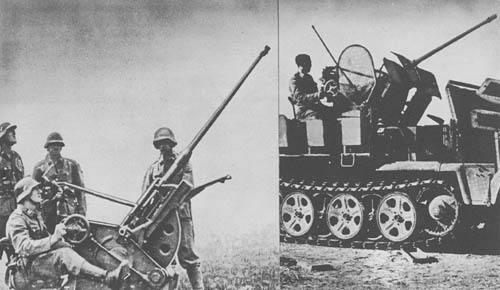
The Flak 30 was the principal armament of German light antiaircraft units since the beginning of the war in Europe until the introduction of the 2 cm Flak 38 and 2 cm Flak 38 Vierling. The gun, which may be mounted on road or railway vehicles, is normally transported on a single-axle trailer which is drawn by either horse or motor vehicle. It is usually fired with its mounting on the ground and with the trailer removed. However, it can be fired from the trailer at both ground or aerial targets in emergencies.
This recoil-operated weapon is fed by a flat 20-round box magazine. The trigger mechanism is pedal-actuated; operation is either full-automatic or semi-automatic.
The barrel slides in the body with the barrel extension. A combined muzzle brake and flash eliminator is screwed to the muzzle and retained by a catch. The barrel extension is slotted on the right and left sides for ejection and feed respectively.
The body is formed to receive the barrel extension, which is hinged near the rear end of the body. The barrel return spring, buffer spring, buffer, and rod and sleeve are housed in a casing secured to the body at the rear.
The sights used are the Flakvisier 35, and the Linealvisier 21, the former is of the reflecting-mirror type with a data-calculating mechanism; the latter is a direct antiaircraft sight embodying course, speed, and range adjustment.
The gun carriage consists of a firm under carriage and a revolving top carriage supported on ball bearings. The under carriage is leveled by three adjustable feet, and is provided with a spirit level. The top carriage has a cradle which is adjustable for elevation. The elevation handwheel is located on the right side of the top carriage, and the traversing handwheel at the back.
SPECIFICATIONS
| Caliber | 2 cm (.79 in.) | |
| Length of tube | ||
| Weigth (travelling position) | 1,697 lb. | |
| Weight (firing position) | 992 lb. | |
| Length (travelling position) | 160 ins. | |
| Length (firing position) | ||
| Height (travelling position) | 63 ins. | |
| Height (firing position) | 29 ins. mounted flush | |
| Width (overall); (travelling position) | 72 ins. | |
| Width of trail spread | ||
| Length of bore | ||
| No. of grooves | ||
| Width of grooves | ||
| Depth of grooves | ||
| Width of lands | ||
| Muzzle velocity | (H.E. shell) 2,950 f.s. (A.P. shell) 2,624 f.s. |
|
| Max. range (horizontal) | 5,246 yds. | |
| Max. range (vertical) | 4,012 yds. | |
| Rate of fire | 120 practical; theoretical 280 | |
| Traverse | 360° | |
| Elevation | +90° | |
| Depression | -10° | |
| Length of recoil | ||
| Ammunition | H.E. (four types); A.P. (two types) | |
| Wt. of 1 magazine of 20 rds | 21 lb. |
German: p. 135